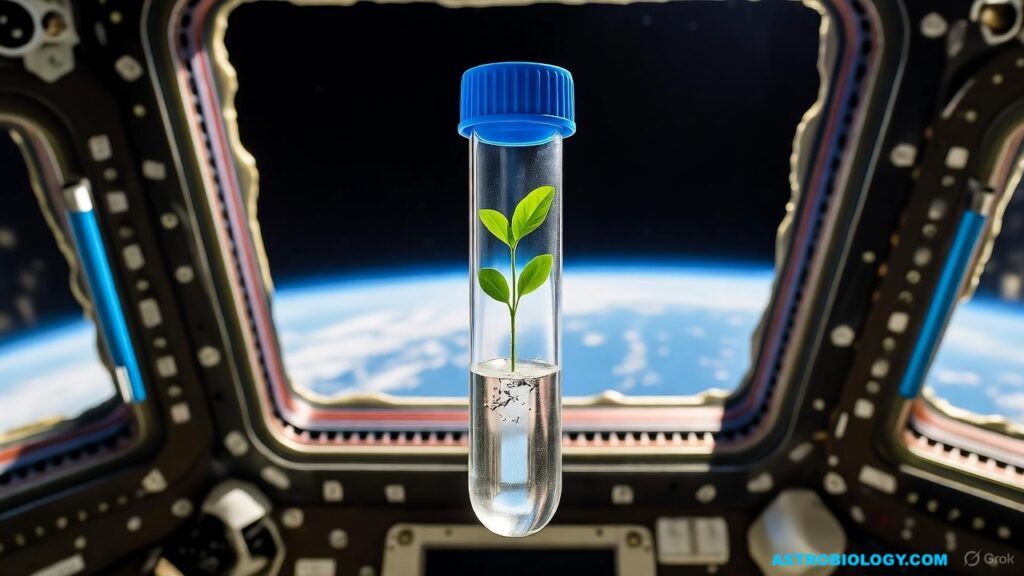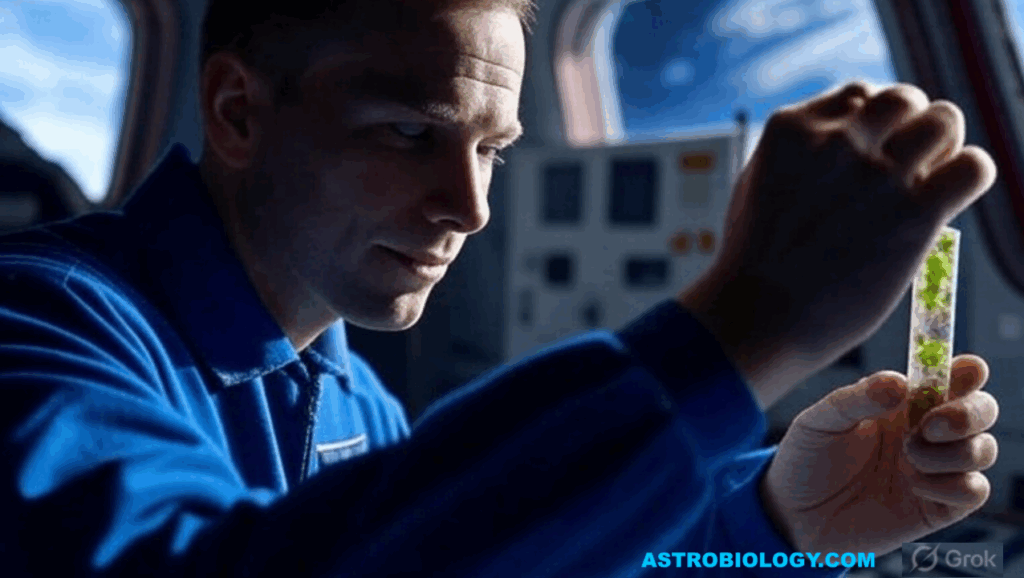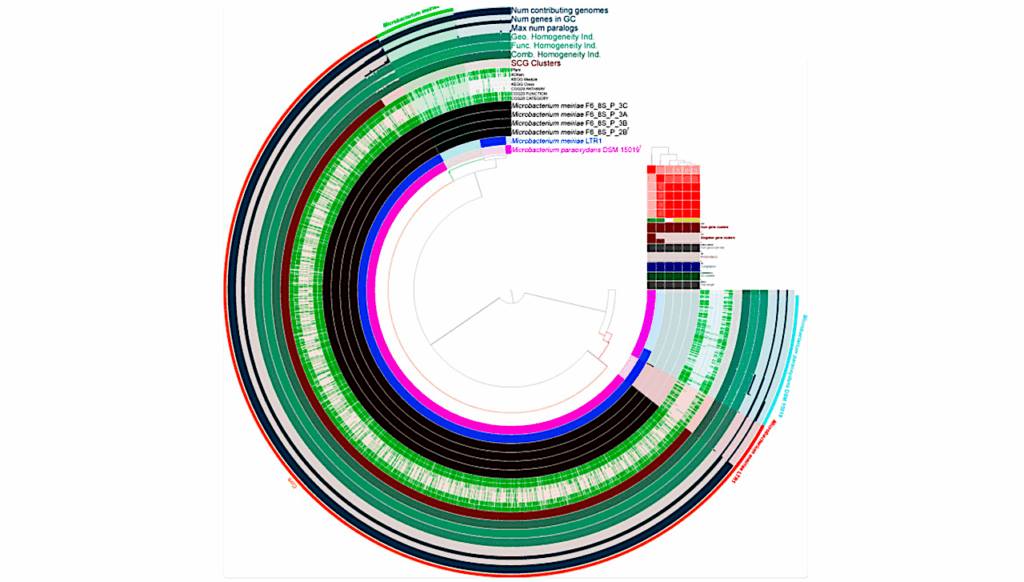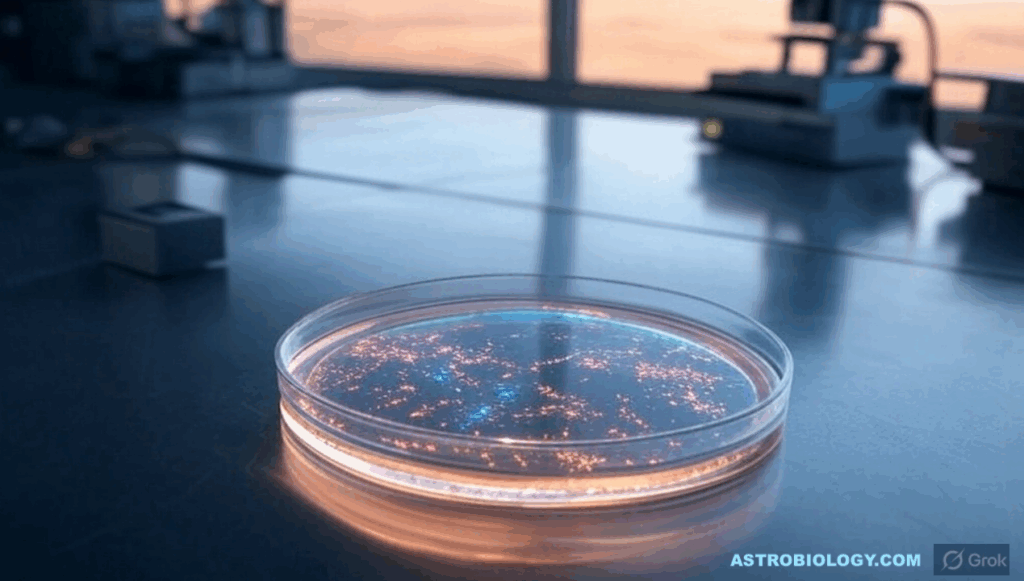NASA Spaceline Current Awareness List #1,172 31 October 2025 (Space Life Science Research Results)
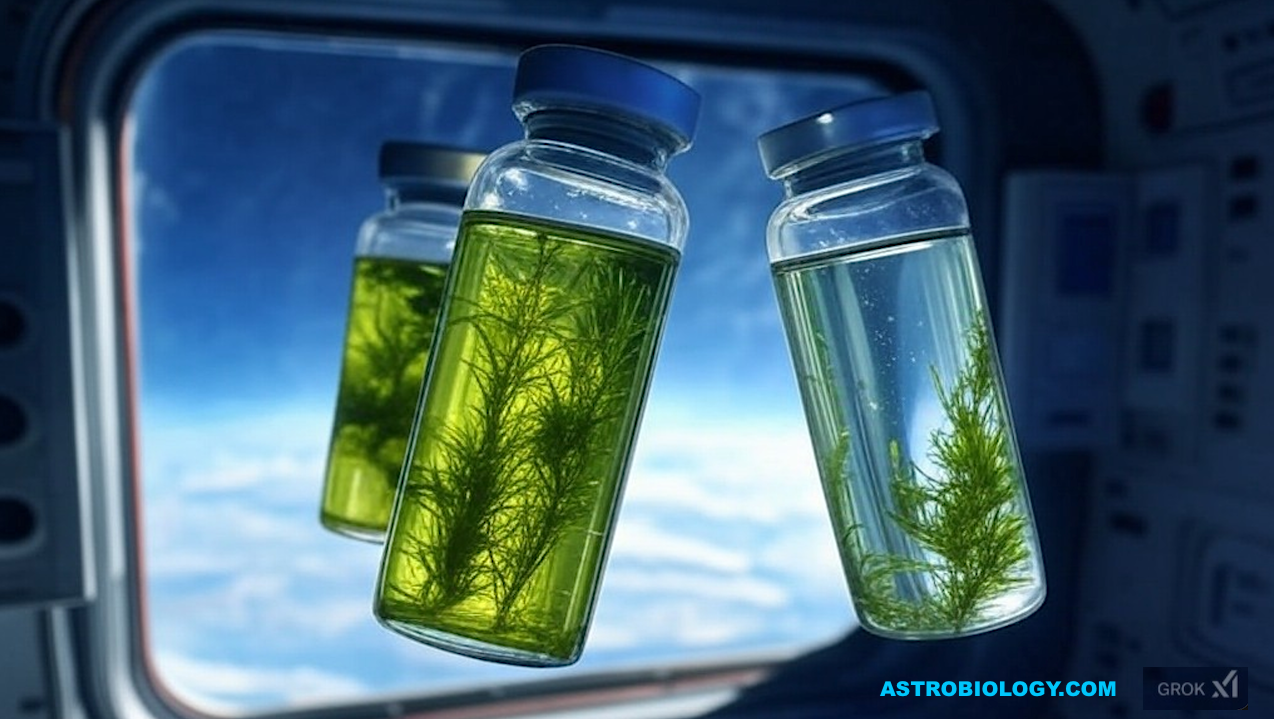
NASA Spaceline Current Awareness Grok via Astrobiology.com
The abstract in PubMed or at the publisher’s site is linked when available and will open in a new window.
Papers deriving from NASA support:
- Ferraro S, Sengupta S, Shaw J, Dave A, Cheli M, Colon R, Zuccotti G, Mason CE, Marcovina S.Point of care testing of biochemical markers for monitoring astronauts during long duration missions in deep space.Clin Chem Lab Med. 2025 Oct 28. Online ahead of print.PI: C.E. MasonNote: From the abstract: “Investigations into human performance and health status during long-duration spaceflights are ongoing aboard the International Space Station (ISS) and are critical for planning missions beyond Low Earth Orbit (LEO). This review evaluates the current evidence on point-of-care-testing (POCT) in space, discussing requirements for POCT to support astronaut health during extended deep space missions and the potential for technology transfer to terrestrial healthcare.”
Journal Impact Factor: 3.7
Funding: “C.E.M. thanks the WorldQuant and GI Research Foundation, NASA (NNX14AH50G, NNX17AB26G, NNH18ZTT001N-FG2, 80NSSC22K0254, 80NSSC23K0832, 24-24NSCOR_2-0008, 24-24FLAG_2-0099 and 22-22SBR_2-0104), the National Institutes of Health (R01ES032638 and U54AG089334) and the LLS (MCL7001-18, LLS 9238-16, 7029-23).” - Seo D, Strickland HF, Zhou M, Barker R, Ferl RJ, Paul AL, Gilroy S.GLARE: Discovering hidden patterns in spaceflight transcriptome using representation learning.npj Microgravity. 2025 Oct 28;11:76.PI: S. GilroyNote: This article may be obtained online without charge.
Journal Impact Factor: 5.1
Funding: “The CARA experiment was supported by grant number GA-2013-104, Center for Advancement of Science in Space, to A.-L. Paul (PI) and R.J. Ferl (CoI). We gratefully acknowledge support from NASA 80NSSC19K0132, 80NSSC19K0126, and 80NSSC21K0577 to S.G.” - Landon LB, Begerowski SR, Roma PG, Whiting SE, Bell ST, Massa GD.Sustaining the Merry Space farmer with pick-and-eat crop production.npj Microgravity. 2025 Oct 27;11:72.Note: This article may be obtained online without charge.
Journal Impact Factor: 5.1
Funding: “This research was supported by the Human Health and Performance Contract NNJ15HK11B and NASA grant Master Task List #1075 (Principal Investigator: G.D. Massa).” - Litzenberg K, Basham R, Naing LY, Mathur P, Woldesellassie F, Landes S, Cowings P, Toscano W, Rashed H, Abell T.Nausea, autonomic function, and the astronauts: Concepts, findings, and applications to GIMD patient care.Dig Dis Sci. 2025 Oct 26. Online ahead of print.Note: This article may be obtained online without charge.
Journal Impact Factor: 2.5
Funding: P. Cowings and W. Toscano are affiliated with NASA Ames Research Center. - Orr C, Mackey E, Jamshidi-Parsian A, Byrum S, Pathak R, Griffin R, Reyna NS.Musculoskeletal miRNA profiling after exposure to simulated space stressors in mice.MicroPubl Biol. 2025 Oct 8:2025.Note: Hindlimb unloading study. This article may be obtained online without charge.
Journal Impact Factor: Not available for this journal
Funding: “Supported by NASA-EPSCoR 80NSSC21M0323 to Rupak Pathak.” - Peanlikhit T, Liu J, Ahmed T, Welsh JS, Karakach T, Shroyer KR, Whorton E, Rithidech KN.Daily consumption of apigenin prevents acute lymphoma/lymphoblastic leukemia in male C57BL/6J mice exposed to space-like radiation.Cancers. 2025 Oct 31;17(21):3513.PI: K.N. RithidechNote: This article is part of Special Issue “Radiation Exposure, Inflammation and Cancers” (https://www.mdpi.com/journal/cancers/special_issues/33Q81IUBU9). The Special Issue also includes articles from previous Current Awareness Lists #1,119 https://doi.org/10.3390/cancers16193392 and and #1,127 https://doi.org/10.3390/cancers16233954. This article may be obtained online without charge.
Journal Impact Factor: 4.4
Funding: “This research was supported by the National Aeronautics and Space Administration (NASA) Grant # 80NSSC19K0435, which was awarded to Rithidech. The APC was funded by the Department of Pathology, Renaissance School of Medicine, Stony Brook University, Stony Brook, NY, USA.” - Wu V, DeMaio R, Jonsson A, Monteleone J, Flickinger K, Weissman A, Guyette F, Buysse D, Birabaharan J, Empey P, Callaway C.Examining the relationship between core temperature, heat balance, and energy expenditure.Ther Hypothermia Temp Manag. 2025 Oct 13. Online ahead of print.PI: K. Flickinger, C. CallawayJournal Impact Factor: 1.0
Funding: “This work was supported by the National Aeronautics and Space Administration (NASA) through a subaward to University of Pittsburgh (PI: Callaway) of grant NNX16AO69A to the Translational Research Institute for Space Health (TRISH) at Baylor College of Medicine.”
Other papers of interest:
- Dang N, Keller J, Barnes F.Biological impacts of hypomagnetic fields in space environment: Implications for artificial magnetic field provision in long-duration spaceflight.Front Space Technol. 2025 Oct 30;6:1704391. Review.Note: This article and the article below (Pelton et al.) are part of Research Topic “Living in Space” (https://www.frontiersin.org/research-topics/71808/living-in-space). Additional articles will be forthcoming and may be found in the link to the Research Topic. This article may be obtained online without charge.
- Pelton JN, Green J.Magnetic shielding systems to support longer-term human exploration of Mars.Front Space Technol. 2025 Oct 27;6:1675939.Note: This article and the article above (Dang et al.) are part of Research Topic “Living in Space” (https://www.frontiersin.org/research-topics/71808/living-in-space). Additional articles will be forthcoming and may be found in the link to the Research Topic. This article may be obtained online without charge.
- Shafirkin AV, Benguin VV, Lishnevsky AE.[Calculations of accumulated and effective residual doses from gcr and erb protons of cosmonauts in long-term MIR and ISS missions with regard to the reparative processes.]Aviakosm Ekolog Med. 2025;5(5):32-42. Russian.
- Ahmadi Hekmatikar A, Suzuki K.Physical activity guidelines for astronauts: An immunological perspective.Biomolecules. 2025 Sep 30;15(10):1390. Review.Note: This article is part of Section “Molecular Biology” (https://www.mdpi.com/journal/biomolecules/sections/bio_molecular_biology) and may be obtained online without charge.
- Cerbone LA.Radiography for in-flight health assessment in the framework of astronauts’ healthcare: A new field for medical physics?Phys Med. 2025 Oct 23;139:105197. Review. Online ahead of print.Note: This article may be obtained online without charge.
- Feng J, Huang W, Wang M, Shi Y, Jiao X, Wang Y, Jiang Y.Enhancing astronaut training: Effects of transcranial direct current stimulation on manual rendezvous and docking skill acquisition.J Neuroeng Rehabil. 2025 Oct 27;22:222.Note: This article may be obtained online without charge.
- Fomina GA, Koloteva MI, Salnikov AV, Smirnov Y.[Effect of prophilactic device braslet on human hemodynamics in the LBNP experiment during short- and long-term space missions.]Aviakosm Ekolog Med. 2025;5(5):43-58. Russian.
- Kashirina DN, Pastushkova L, S. KA, Brzhozovsky AG, Smirnov Y, Nikolaev EN, Larina IM, Orlov OI.[Analysis of cosmonauts’ blood protein dynamics in the course of long-term space missions.]Aviakosm Ekolog Med. 2025;5(5):43-58. Russian.
- Deng Q, Wen Y, Liu C, Yue X, Sun J, Han Y.An emerging paradigm for scientific decision: The AI evaluation of space science projects.Life Sci Space Res (Amst). 2025 Nov;47:84-94.
- Khomich V, Yamshchikov V, Bykov N, Kuryachii A, Shakhmatov E.Influence of the body force distribution generated by plasma actuator on the induced near-wall flow.Acta Astronaut. 2026 Jan;238:686-95.
- Shah J, Lee R, Pathuri S, Zheng J, Ong J, Suh A, Rezaei K, Mudhar G, Parsons AD, Park J, Lee AG.The brown bear and hibernating mammals as a translational model for human resilience: Insights for space medicine, critical care, and austere environments.Biology (Basel). 2025 Oct 17;14(10):1434. Review.Note: This article is part of Section “Physiology” (https://www.mdpi.com/journal/biology/sections/Physiology) and may be obtained online without charge.
- Yuan S, Wang W, Liang Z, Fang W, Liu Y, Zhao L, Zhong R, Sun Y.Domestication of radiation sensitive Caenorhabditis elegans strains suitable for liquid culture systems in long-term space missions.Life Sci Space Res. 2025 Oct 29. Online ahead of print.
- Kamada K, Mannoji H, Tohyama T, Nishikawa T, Tsutsui H, Sunagawa K, Saku K.Simulated microgravity exposure markedly attenuates the baroreflex total loop gain and induces orthostatic hypotension in male rats.Physiol Rep. 2025 Oct 27:e70637. Online ahead of print.Note: Hindlimb unloading study. This article may be obtained online without charge.
- Qin Y-H, Wang A-L, Yan L-B, Wang H-H, Yang C-J, Sun S-Q, Hong M.Dynamic regulation of neuroinflammation and mechanism of EZH2 and related miRNAs under simulated microgravity.Acta Astronaut. 2026 Jan;238:677-85.
- Wang J, Zheng D, Zhao C, Xuan X, Zhang X, Li R, Xu K, Zeng Y, Tao Y, Lu D, Liu L, Zhao S, Liu Y, Wu J, Du J.Long-term effects of simulated microgravity in the central nervous system of rhesus monkeys: A voxel-wise multimodal MRI study.Front Physiol. 2025 Oct 23;16:1634366.Note: This article is part of Research Topic “Bioconvergence: A New Frontier for Understanding and Enhancing Human Adaptations to Extreme Environments” (https://www.frontiersin.org/research-topics/68632/bioconvergence-a-new-frontier-for-understanding-and-enhancing-human-adaptations-to-extreme-environments). The Research Topic also includes an article from previous Current Awareness List #1,166 https://doi.org/10.3389/fphys.2025.1637834. Additional articles will be forthcoming and may be found in the link to the Research Topic. This article may be obtained online without charge.
- Yang F, Chen C, Yang C, Chen R, Liu Z, Wen L, Xiao H, Zhou L, Geng B, Xia Y.Exosome-mediated perturbation of the immune-bone metabolism axis: A mechanistic investigation into bone loss in a simulated microgravity environment.Artif Cells Nanomed Biotechnol. 2025 Dec;53(1):494-513.Note: From the abstract: “…this study established a simulated microgravity and normal gravity control experimental system using the Rotating Wall Vessel (RWV) and Rotating Cell Culture System (RCCS), both developed by the National Aeronautics and Space Administration (NASA) of the United States.” This article may be obtained online without charge.
- Yang M, Qiu Y, Bi L, Xian J, Li Z, Yao J, Jin H.Decreased myocardial glucose uptake precedes cardiac dysfunction in hindlimb unloading mice revealed by dynamic 18F-FDG PET imaging.Life Sci Space Res. 2025 Nov;47:140-52.
- Yu Y, Zheng Y, Zhang H, Fan X, Guo J, Sun L, Tang L, Ta D.Abdominal LIPUS ameliorates simulated microgravity induced skeletal muscle atrophy via the gut-muscle axis.npj Microgravity. 2025 Oct 27;11(1):73.Note: From the abstract: “Mice were divided into three groups: normal control, hindlimb unloading, and hindlimb unloading with abdominal LIPUS intervention.” This article may be obtained online without charge.
- Artamonov AA.[Mathematical model of the effects of low-intensity electromagnetic fields on bio-objects.]Aviakosm Ekolog Med. 2025;5(5):14-22. Russian.
- Bhandari DD, Kim S-J, Brandizzi F.Fortifying the frontier: Cell wall modifications during plant immunity.Curr Opin Plant Biol. 2025 Dec;88:102816.
- Kudriavtseva NS.[Assessment of the potential to use lunar resources for life support to a lunar base crew.]Aviakosm Ekolog Med. 2025;5(5):84-90. Russian.
- Parveen A, Vassilieva G, Popova Y, Novikov V, Savinkina A, Platat C.Effects of an 8-month isolation on body composition and cardiopulmonary exercise testing.Acta Astronaut. 2025 Oct 24. Online ahead of print.
- Pashkova DV, Popova OV, Popova Y, Loktionova Y, Zharkikh EV, Dunaev AV, Rusanov VB.[Neurovegetative regulation of the cardiac rhythm and functional condition of microcirculation vessels in a 12-month isolation study.]Aviakosm Ekolog Med. 2025;5(5):59-69. Russian.
- Kamat V, Bao K, Grumbine MK, Tsumura L, Hermanson JC, Kramlich J, Pyle L, Lim R, Chao J, Hass D, Hurley J, Sweet IR.Incorporation of gas/liquid equilibration control into a perifusion system to measure tissue specific O2 concentration dependency of O2 consumption rate.Am J Physiol Cell Physiol. 2025 Oct 25. Online ahead of print.
Astrobiology, space biology, microgravity, space emdicine,


